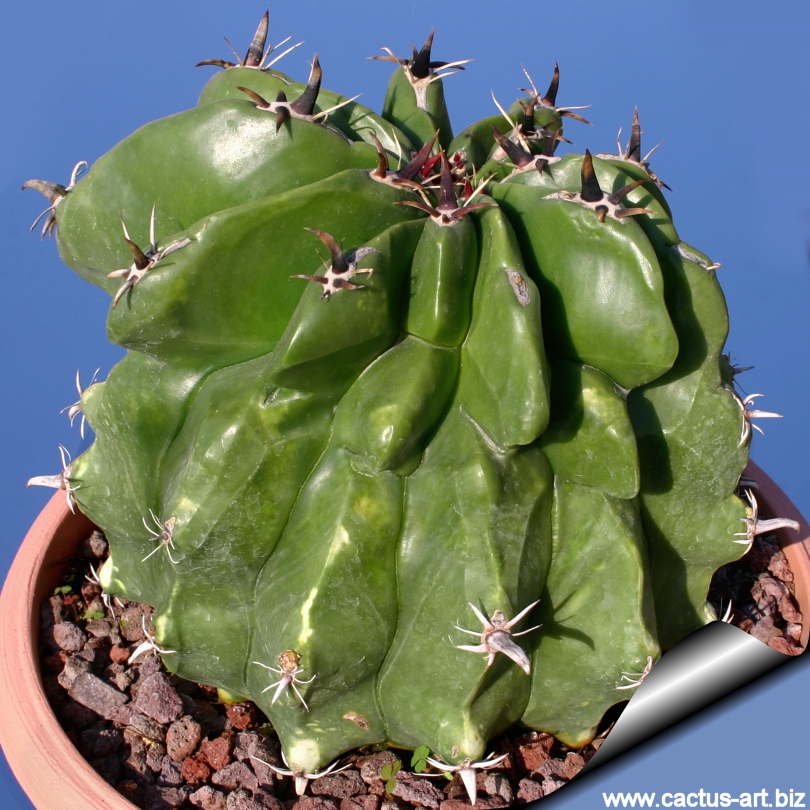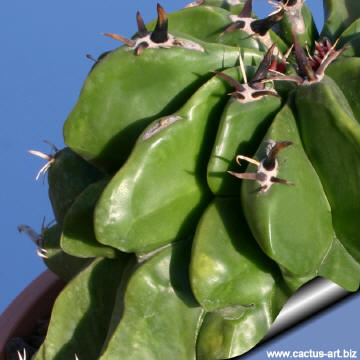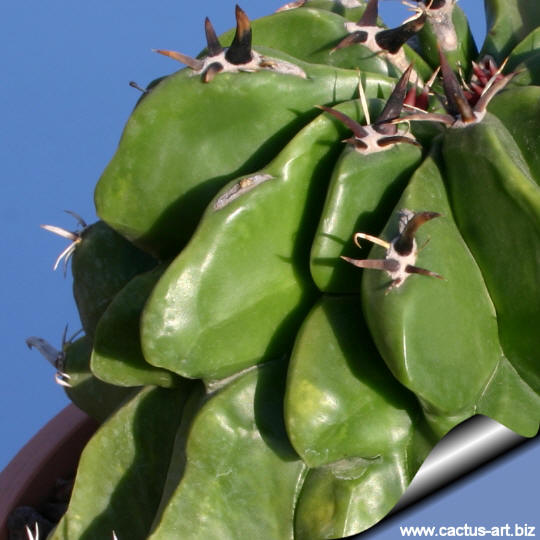|
|
|

Ferocactus horridus var. brevispinus "Chinned form"
A large well
grown plant is truly an achievement.
|
|
Description: F.
horridus “brevispinus” is a solitary
fast growing little barrel cactus with quite short and stocky cental
spine one (not enough to call it curved!)
The strange and very rare "Chinned form" has peculiar
chinned ribs, this characteristic is not evident in young specimen, but
will appears only in 10 or more years old plant and will progressively
enhance as the plant older. The "chins" at first bear a
spiny areole, but as the plant older the areoles on the chin loose their
spines. In very old specimen the chins becomes completely naked without
areoles, smooth and shining. A large well grown plant is truly an
achievement.
Stem: Round to elongated dark green 25-40 cm in diameter 40-100
tall.
Central spines: Has a very short but strong, recurving
brownish-grey, large central spine. Slightly hooked or just with a
slight kink at the end. Very dark red to almost black that can take a
chalky colour ageing.
Radial spines: 7-10 short, straight but stout
Flower: Orange/Yellow and have orange or red midviens.
Fruit: Lemon yellow.
Seeds: Black. shining.
|
|
 |
Cultivation:
F. horridus
is a summer-growing and pretty easy species thought
slow to start. It is suited for any rich, well
drained soil such us clay, pumice, lava grit, and only a little
peat or leaf-mould. If potted, repot preferably in the spring, if their
roots become cramped. Generally, they should be repotted every
other year in order to provide fresh soil. However, this doesn't
necessarily mean they'll need larger containers. Fill about a quarter of
the pot with broken crocks, gravel, etc. to promote good drainage. After
repotting, do not water for a week or more. Water regularly during the
aestival growth cycle (this plant need plenty of water, but do not
overwater and let their soil dry out between waterings),
and also needs to be avoided wetting the body
of this plant while it is in sunlight. A wet cactus in the sun light can
cause sun burning which can lead to scares or even fungal infections and
death, keep rather dry in winter. No water should ever be allowed to
stand around the roots. Feed with a high potassium fertilizer in summer.
|
Exposure: Outside they need a bright exposure,
full sun or half shade in summer if the location is exceedingly hot or
bright, inside needs bright light, and some direct sun.
It can tolerate moderate shade, and a plant that has been growing in
shade should be slowly hardened off before placing it in full sun as the
plant will be severely scorched if moved too suddenly from shade into
sun.
Frost Tolerance: Light frost protection required for
safe cultivation, but can tolerate sporadic light frost. This
plants need a period of cool rest in winter to produce flowers
abundantly.
Diseases and pests:
Watch for infestations of
mealybug, scale insects and spider mite.
Plant in good conditions will
start to bloom when reach the diameter of only 15-18 cm. |
|
Advertising
|
|
|
|
|
Family:
Cactaceae (Cactus
Family)
Scientific name: Ferocactus
horridus f. brevispina mostruosa
Origin: F. horridus came from Mexico
(Southern Baja California) but this short spined
form is presumably of
garden origin (Nursery
selected form)
Habitat: Grows in grit on the hill-sides.
It gets lots of water in two months and lots of sun all year.
Conservation status: Listed in
CITES appendix 2.
Synonyms: Ferocactus
peninsulae var. brevispinus
This plant is sometime referred as : Ferocactus herrerae var.
brevispinus
|
|
|
|

|
|
Propagation:
It can be reproduced exclusively by
cuttings. The cuttings will take root in a minimum
temperature of 20° C. Cuttings of healthy shoots can be taken in the
spring and summer, Cut them with a sharp, sterile knife, leave the
cutting in a warm, dry place for a week or weeks (depending on how thick
the cutting is) until a callus forms over the wound. Once the callus
forms, the cutting may be inserted in a container filled with firmed
cactus potting mix topped with a surface layer of coarse grit. They
should be placed in the coarse grit only; this prevents the cut end from
becoming too wet and allows the roots to penetrate the rich compost
underneath, they root easily with no further assistance. Just let
them lay on the soil and you have a new start. The
cuttings should root in 2 to 8 weeks. It is also possible to reproduce
it by seeds but the result is unpredictable.
|
|
Photo of
conspecific taxa, varieties, forms and cultivars
of plants belonging to the
Ferocactus peninsulae/wislizenii
complex
(This
Taxon has various synonyms ( like many other cacti)
whit several controversial varieties and subspecies and comprises a
multitude of different forms, but where each form is linked to others by
populations of plants with intermediate characteristics):


|
|